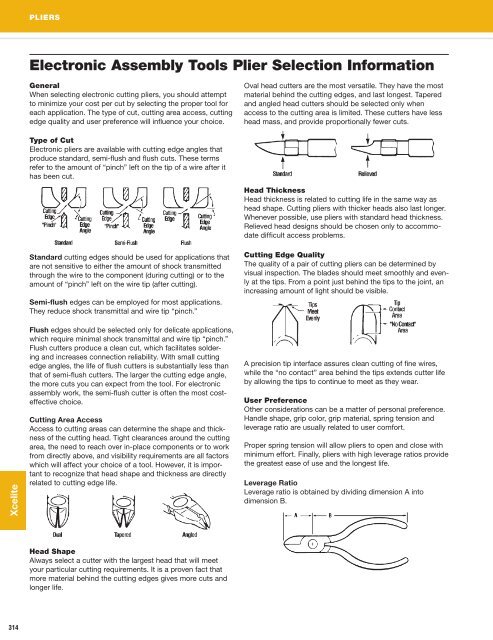Create successful ePaper yourself
Turn your PDF publications into a flip-book with our unique Google optimized e-Paper software.
PLIERS<br />
Electronic Assembly Tools Plier Selection Information<br />
General<br />
When selecting electronic cutting pliers, you should attempt<br />
to minimize your cost per cut by selecting the proper tool for<br />
each application. The type of cut, cutting area access, cutting<br />
edge quality and user preference will influence your choice.<br />
Oval head cutters are the most versatile. They have the most<br />
material behind the cutting edges, and last longest. Tapered<br />
and angled head cutters should be selected only when<br />
access to the cutting area is limited. These cutters have less<br />
head mass, and provide proportionally fewer cuts.<br />
Type of Cut<br />
Electronic pliers are available with cutting edge angles that<br />
produce standard, semi-flush and flush cuts. These terms<br />
refer to the amount of “pinch” left on the tip of a wire after it<br />
has been cut.<br />
Head Thickness<br />
Head thickness is related to cutting life in the same way as<br />
head shape. Cutting pliers with thicker heads also last longer.<br />
Whenever possible, use pliers with standard head thickness.<br />
Relieved head designs should be chosen only to accommodate<br />
difficult access problems.<br />
Standard cutting edges should be used for applications that<br />
are not sensitive to either the amount of shock transmitted<br />
through the wire to the component (during cutting) or to the<br />
amount of “pinch” left on the wire tip (after cutting).<br />
Semi-flush edges can be employed for most applications.<br />
They reduce shock transmittal and wire tip “pinch.”<br />
Cutting Edge Quality<br />
The quality of a pair of cutting pliers can be determined by<br />
visual inspection. The blades should meet smoothly and evenly<br />
at the tips. From a point just behind the tips to the joint, an<br />
increasing amount of light should be visible.<br />
<strong>Xcelite</strong><br />
Flush edges should be selected only for delicate applications,<br />
which require minimal shock transmittal and wire tip “pinch.”<br />
Flush cutters produce a clean cut, which facilitates soldering<br />
and increases connection reliability. With small cutting<br />
edge angles, the life of flush cutters is substantially less than<br />
that of semi-flush cutters. The larger the cutting edge angle,<br />
the more cuts you can expect from the tool. For electronic<br />
assembly work, the semi-flush cutter is often the most costeffective<br />
choice.<br />
Cutting Area Access<br />
Access to cutting areas can determine the shape and thickness<br />
of the cutting head. Tight clearances around the cutting<br />
area, the need to reach over in-place components or to work<br />
from directly above, and visibility requirements are all factors<br />
which will affect your choice of a tool. However, it is important<br />
to recognize that head shape and thickness are directly<br />
related to cutting edge life.<br />
A precision tip interface assures clean cutting of fine wires,<br />
while the “no contact” area behind the tips extends cutter life<br />
by allowing the tips to continue to meet as they wear.<br />
User Preference<br />
Other considerations can be a matter of personal preference.<br />
Handle shape, grip color, grip material, spring tension and<br />
leverage ratio are usually related to user comfort.<br />
Proper spring tension will allow pliers to open and close with<br />
minimum effort. Finally, pliers with high leverage ratios provide<br />
the greatest ease of use and the longest life.<br />
Leverage Ratio<br />
Leverage ratio is obtained by dividing dimension A into<br />
dimension B.<br />
Head Shape<br />
Always select a cutter with the largest head that will meet<br />
your particular cutting requirements. It is a proven fact that<br />
more material behind the cutting edges gives more cuts and<br />
longer life.<br />
314

















